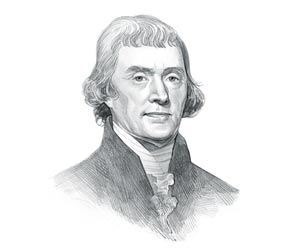|
Two-thirds of the people still lived on or near
rivers and the coast. But already nearly 400,000 people
lived west of the Allegheny Mountains. In 1790 the
centre of population had been east of Baltimore by 1800
it had moved 18 miles west of that city.
US History in 1800 for kids: Cities and Towns
The US History in 1800:
In 1800 the largest city in the United States of America was
Philadelphia. The town of Philadelphia had a population of
70,000 people. New York was the second largest city in terms of
population. Other cities in the US were much smaller at this time
with populations less than 30,000 people.
For additional facts refer to the
History of Urbanization in America
US History in 1800 for kids: Government in Washington
The US History in 1800:
The new US capital and seat of government had been moved from
Philadelphia to Washington. But the new capital in Washington was
only just being constructed. In 1800 Washington consisted of one
long, wide street which had been called Pennsylvania Avenue. The
design of Pennsylvania Avenue led from the unfinished Capitol to the
unfinished White House.
Congress held its sessions in a temporary
wooden building. The remainder of Washington consisted of a few
inexpensively built and very uncomfortable boarding houses.
US History in 1800 for kids: Travel by Road
The US History in 1800:
Traveling in the early days of the 1800's was extremely arduous,
time consuming and difficult. Before 1800, sea routes, basic post
routes, and a few navigable rivers were the only ways to cover long
distances. There were no links the East Coast to lands beyond the
Appalachian Mountains. Travel was undertaken by road on horseback in
coaches or by water. On a good day it might be possible to cover an
area of 40 miles, however a distance of 25 miles was the average
amount of distance that could be covered in one day. In the year
1800 the time required for the trip along the post route from
Portland, Maine to Louisville in Georgia took 20 days.
The stage
coach was the most common form of transport. A stage coach might
carry 12 people, all cramped into one wagon. Stage coaches were
basic providing uncomfortable travel jolting over rough roads.
Only leather flaps, buttoned to the roof and sides, of the stage
coach protected travelers from the heat and dust of the summer to
the severe cold and snow of the winter. South of the Potomac River
there were no public stage coaches available and travelers had no
alternative but to ride on horseback. The early inns provided
stopping points for travelers but these were generally uncomfortable
and supplied poor food.
The first turnpike opened in 1794 between
Lancaster and Philadelphia. For additional facts and information
about later transportation refer to
Construction
of the Cumberland Road, the
History of the Turnpikes,
the
Horse Car,
the
Santa Fe Trail and the
Oregon Trail.
US History in 1800
for kids:
The Railroads came later...
The info about the US History in 1800 provides interesting facts and
important information about important events and the
progress of the United States during the early presidency of the 3rd President of the United States of America.
The development of the railways started later in the 1830's, for
facts and info refer to the
Railroads in
the 1800s.
US History in 1800 for kids: Travel by Water
The US History in 1800:
Whenever it was possible the traveler went by water. Sea travel was
dangerous and navigation was difficult as there were few lighthouses
and there were no public buoys to guide the sailors. Travel by river
was a better option and early pioneers, leaving Pittsburg, floated
down the Ohio River in flatboats and
settled Cincinnati. Other travelers
went farther down the river to Louisville, in Kentucky, and others
founded the cities of Wheeling and Marietta. Flatboats, popularly
referred to as 'Flats', were flat-bottomed boats without keels that
navigated the Mississippi, Tennessee and Cumberland Rivers. They
were important forms of transportation carrying produce to markets
throughout the state and transporting passengers. For additional
facts and information refer to the
Steamboats of the
1800's
and the
Erie Canal. |

